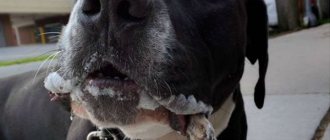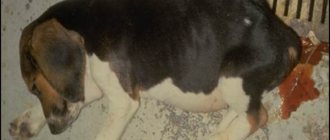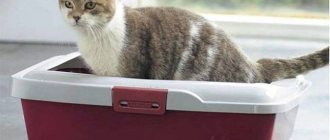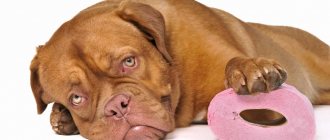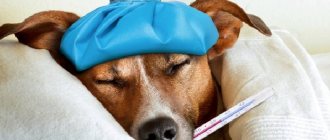A small amount of mucus in a dog's stool is considered normal. This is necessary to facilitate the passage of feces through the intestines; the mucous secretion acts as a natural lubricant. A large volume of mucus, especially mixed with blood, is a reason for examination. It is important to pay attention to the act of defecation itself, how much the pet strains, and the frequency of sitting down.
Diarrhea with mucus in a dog is accompanied by additional symptoms: lethargy, abdominal pain, decreased/lack of appetite, changes in stool, etc.
Why do dogs have mucus in their stool?
Mucus covers the mucous membranes with a thin layer. It protects the throat, lungs, and intestinal walls from the influence of dangerous pathogens and unfavorable factors. Usually it is produced transparent and liquid. This is the norm, but illness, the dog’s diet and aggressive environment can change the consistency of the mucus and its color.
Visually noticeable mucus in the stool of dogs and puppies may indicate illness. When feces move through the colon, mucus acts as a lubricant that helps them move to the anus, so there is little of it in “proper poop.” And if the owners do not look closely, they will not notice that the pet pooped stool with small splashes of transparent or yellow color. But if it is visually noticeable, then this is a sign of health problems. This signal tells the owner: “Attention. Start taking action."
To help your veterinarian make a diagnosis, look for the presence or absence of other symptoms:
- blood or pus in large or small quantities;
- pain in the abdomen - to do this, try running your hand over it; if the dog shudders, it means it is experiencing unpleasant or painful sensations;
- changes in bowel movements frequency, consistency, color.
Important! Vomiting and diarrhea without other symptoms may occur in dogs 1
–
2 times a month.
This is a physiological feature of cleaning the predator’s body, which does not require treatment. Dehydration and constipation cause extra mucus in the stool.
In addition, it almost always accompanies the following diseases and pathologies:
- bacterial infections caused by bacteria such as Campylobacter, Salmonella, Shigella and Yersinia;
- tear in the mucous membrane due to hard stools or diarrhea;
- ulcers;
- inflammation of the mucous membrane;
- intestinal obstruction;
- ulcerative colitis;
- food allergy to lactose or gluten;
- intestinal parasites;
- fungal infections;
- polyps and intestinal tumors;
- parvovirus;
- irritable bowel syndrome.
If you notice changes in fecal matter, make an appointment with your dog at the veterinary clinic. You will need to have your stool tested, so you can collect it in a glass or plastic container before your visit to the doctor. This sample will be used to identify parasites, bacteria and other diseases.
Did you know? Licking the face helps your dog relieve stress. But if a pet licks its owner, then it is either hungry or wants to play.
Irritable bowel syndrome
Considering pathological ailments, start with irritable bowel syndrome. This is a condition in which the inflammatory process causes the body to produce an additional layer of protective mucous membrane.
Due to this, the following is observed in the dog’s feces:
- not fully formed stool;
- excess mucus;
- splashes of bright scarlet blood.
The reasons that led to the appearance of stool with mucus may be:
| Cause | Features of the pathology | What to do |
| Stress | Anxiety causes diarrhea or mild constipation in most dogs. | If you do not disturb the animal, the symptoms of stress go away on their own within 24–48 hours. |
| Indiscriminate eating | The pet ate something that caused intestinal upset, flatulence and vomiting. Typically, these foods include dairy products, undercooked eggs, raw meat or bones, and fried or fatty foods. | Rinse the intestines with an aqueous solution and salt. For dogs weighing up to 10 kg, dilute 1 dessert spoon of salt in 250 ml of water, 10–30 kg - 1 tbsp. l., more than 30 kg - 2 tbsp. l. Then they give a sorbent (activated carbon) and vaseline oil. To do this, crush 5–20 tablets of coal and mix with 1 d spoon of oil. The charcoal will collect the remaining toxins, and the oil will help remove them. |
| Poor nutrition | There are changes in diet. In this case, mucus is a sign that the digestive system is trying to adapt to the new diet. | New food should always be introduced gradually, starting with small amounts. |
| Intoxication | The dog ate inedible things: poison, chocolate, grapes/raisins, chewing gum. Additional symptoms are unsteady gait, lethargy, fainting, and convulsions. | You can start by removing toxins from the stomach in the same way as in case of poisoning, and then be sure to take the dog to the veterinarian or immediately arrange an examination. |
Allergy
An allergy is a protective reaction of the body to a substance.
Just like food intolerance, it causes stomach upset, which is accompanied by:
- vomiting;
- flatulence;
- diarrhea with mucus.
Chronic diarrhea can also be the result of eating foods that are toxic to dogs.
Inflammatory processes in the intestines
Inflammatory bowel disease is a process in which the gastrointestinal tract is attacked by bacteria, viruses or other microorganisms. To resist them, the layer of mucus covering the walls increases. The cause of the disease is low immunity, metabolic disorders and chronic diseases.
Among the main diseases:
- gastritis - inflammation of the mucous membrane and intestinal walls (in severe form);
- enteritis - an inflammatory process in the small intestine;
- gastroenteritis - simultaneous inflammation of the small intestine and gastric mucosa;
- colitis - inflammation localized in the large intestine;
- enterocolitis - simultaneous inflammation of the small and large intestines;
- Gastric ulcer is a defect in the intestinal mucosa or submucosal layer.
The set of reasons for all types of inflammatory processes is the same. These are intestinal parasites, poor quality food, poisoning, allergies, tumors, bacterial infection.
Did you know? A dog moves 66% faster than a person, so walking with your pet is useful for those who want to lose weight or maintain their weight at a normal level.
Gastritis
Gastritis is possible in acute and chronic forms. Acute is caused by poor quality food and poisoning or a swallowed foreign object. Gastritis develops very quickly.
Dog:
- experiences stomach pain;
- refuses food;
- body temperature rises.
The dog limits physical activity. The process of defecation is disrupted, and constipation or diarrhea may occur.
Gastroenteritis
The main symptom of gastroenteritis is simultaneous vomiting and diarrhea. The stool can be anything from soft to liquid, but in 90% of cases it is accompanied by vomiting.
Symptoms of the disease:
- decreased appetite;
- tarry feces with mucus;
- lethargy;
- salivation;
- nausea;
- dehydration.
If there is blood in the stool, then it is hemorrhagic gastroenteritis.
Important! Inflammatory bowel processes are more common in German Shepherds and Shar-Peis than in other breeds.
Colitis
The first symptoms of colitis are loose stools and frequent urge to defecate. There may be excessive mucus and blood in the stool.
The process is accompanied by:
- increased gas formation;
- rumbling in the intestines.
If the disease progresses, the pet will become picky about its diet, lose appetite and begin to lose weight. Colitis is caused by stress, infections and parasites.
Enterocolitis
More often, young and old dogs suffer from enterocolitis, since their immune system cannot cope with environmental aggression.
Symptoms of the disease:
- apathy;
- reluctance to walk;
- bloating and flatulence;
- stomach pain;
- diarrhea with mucus;
- vomiting is possible.
Due to frequent bowel movements, your pet may experience itching in the anus area, causing it to start rubbing its butt on the floor.
Colitis
Colitis is an inflammation of the large intestine . There can be many reasons for this phenomenon, from infectious diseases to all kinds of poisoning. But there is only one outcome - the colon mucosa becomes inflamed, most often of the catarrhal type, when a large volume of mucus is released.
How can you understand that your pet has colitis and not something else? It is quite difficult to do this without the appropriate education and skills, but there are still specific signs:
- The pet constantly asks to go for a walk in order to go “big”, but he is not doing well with the act of defecation. No matter how much the dog strains, feces are not released, or it comes out, but in portions and with a lot of mucus.
- The process of defecation is accompanied by a pronounced pain reaction. The dog howls and wheezes, trying to squeeze something out of himself.
- The animal begins to vomit . Very strong and “explosive”, vomit literally flows out of pets like a fountain. This is due to the fact that compressed feces in the inflamed intestines are a real toxic “bomb”. Simply put, a powerful source of toxins appears in the dog’s body.
Unfortunately, owners of sick dogs do not always take their pets to the veterinarian. Moreover, they try to cure them of “constipation” on their own by giving them oils and other “potions.” It’s not difficult to guess what all this leads to - the disease “ripens” to an extremely advanced stage; during defecation, not just mucus flies out of the animal, but a mixture of blood and exfoliated areas of the epithelium. If you don’t help the dog in time, it will die (and no one can guarantee successful treatment in such situations).
How to diagnose and determine the cause
Diagnostics begins with:
- examination of the dog;
- owner survey.
The doctor will ask what your stool was like before and how it has changed recently. Depending on the suspected cause, different types of tests may be ordered. Stool samples with mucus will definitely be examined. When diagnosing helminths, you will need to test feces several times, since they may not be in every portion.
In some cases:
- carry out a blood test;
- X-rays and computed tomography are prescribed.
This is necessary in order to visualize the state of the gastrointestinal tract. The veterinarian will also need everything that the owners can tell about the dog’s diet, nutrition and living conditions. This will help clarify the diagnosis.
Dysbacteriosis
This is the name for a disorder in the microflora of the stomach or intestines. Adverse factors can affect the amount of natural microflora in a dog's stomach. It either decreases or disappears altogether. The empty “niche” is occupied by another microflora that does not suit the animal’s stomach. The reasons for the development of dysbiosis in a dog can be:
- diseases;
- certain medications;
- frequent stress.
Among the medications that cause the development of dysbiosis, antibiotics are distinguished, since their action disrupts the natural environment of the stomach, which allows the development of bacteria such as salmonella or E. coli.
The disease is often accompanied by a sharp decrease in appetite, lethargy, and apathy. In addition, an upset stomach in a dog can also be a consequence of the development of this disease. There is a fairly high probability that an animal suffering from dysbiosis will have mucus in its stool. You should not delay the treatment of dysbiosis, because the absence of natural microflora is a very dangerous condition for a dog.
Treatment of mucus in stool in dogs
In cases involving a change in diet or a reaction to food eaten, the presence of mucus in the stool is just a small incident. The symptom will disappear in a couple of days. At the same time, the dog remains cheerful, also actively plays and eats. There is no need to treat it or go to the doctor. Add probiotics or yoghurts with live bacteria to the food to maintain intestinal microflora and monitor it.
Important! Increased mucus production means that a change in treatment is needed or that current treatment is not as effective as before.
If the mucus is accompanied by other symptoms, then a doctor’s consultation is required to begin a course of treatment. It will depend on the cause of the disease and the diagnosis.
| Disease | Diet and care | Treatment |
| Allergy | The product that caused the allergy is excluded from the diet. In the future, any innovation is started with small portions and the pet’s reaction is monitored. Bathe your dog more often to remove pollen from its fur if allergies are of plant origin. Use modern air purifiers to help your pet's breathing. | Drug treatment of the disease will include: antihistamines - Claritin, Tavegil, Fenistil, Suprastin, Diazolin, Diphenhydramine. For Yorkies and small breed dogs, it is better to give Diazolin. The rest are usually prescribed Suprastin 2 mg/kg per day. The dose is divided into 3 feedings and given with food. Corticosteroids are prescribed as nasal drops to reduce inflammation. For example, Nasonex. It is injected into each nostril 1-2 times a day. |
| Inflammation of the mucous membranes (gastritis, enteritis, gastroenteritis, colitis) |
| To protect the mucous membrane and relieve inflammation, antacids are prescribed - Almagel, Phosphalugel, De-Nol. Dosage - 0.5 scoop 3 times a day. Antibiotics are prescribed to eliminate bacterial infections: Amoxiclav 12.5 mg/kg for a week, Gentamicin 4.4 mg/kg 2 times a day for 3–5 days. To relieve spasms, antispasmodics are needed: “No-shpa” 0.5 t. 2 times a day, “Spazmalgin” 0.5 t. 3 times a day. |
| Ulcer | A gentle diet with a minimum amount of fat and salt. | The intestinal walls are corroded by gastric juice. To reduce its production, Ranitidine, Omeprazole, and Cimetidine are used. To prevent electrolyte imbalances, droppers are prescribed: Ringer's solution 10–20 ml/kg; to support the liver - “Hemodez” 5–10 ml/kg 1–2 times a day. If your pet is bothered by vomiting, then antiemetics “Metoclopramide” and “Chlorpromazine” are prescribed. Antacids will reduce inflammation of the intestinal walls. These are “Sukrat”, “Venter”, “Sucralfate”. If there is a bacterial infection, a course of antibiotics will be prescribed. If necessary, use a hemostatic agent: “Vikasol” at a dosage of 1 mg/kg for 3–5 days. |
| Internal parasites | The food is ordinary. But it needs to be supplemented with iron to relieve anemia and normalize hematopoiesis. | Anthelmintic drugs are used for treatment. The choice of medication will depend on the type of parasite. For example, for protozoa: “Albendazole”. Course of treatment - 2 rubles. 25 mg/kg. For helminths: “Febtal-combo” - 1 ml/kg or other drugs. Other broad-spectrum anthelmetics: Drontal, Milbemax, Kanikvantel. The dosage is chosen in accordance with the weight of the dog indicated in the instructions for the drug. |
| Dysbacteriosis | The diet should include vegetables, lean meat, and cereals. | Treatment for dysbiosis will vary depending on the cause, the severity of the damage to the body and the pet's health. If there was vomiting or diarrhea, then antiemetic and antidiarrheal drugs are prescribed. It is then important to introduce electrolytes into the body to restore balance. They do this with droppers. Medicinal enzyme supplements should restore the bacterial balance in the intestines. Mezim or Cholenzym are prescribed. Probiotics are prescribed to improve microflora in dogs - “Lactobifid”, “Lactoferon”, “Fortiflora”, “Multibacterin Omega 10”. The course duration and dosage are determined based on test results. |
General symptoms
Liquid stool (diarrhea) is not considered a dangerous condition if it lasts no more than 3-5 days. However, the dog owner should take a close look at his pet's stool. The feces of your four-legged friend may contain mucus, undigested food particles, and blood. It is very important to monitor the color of the stool, because an unnatural shade of feces indicates the presence of certain disorders:
- pale stool is a sign of liver pathologies,
- black color of feces - the dog has internal bleeding,
- green tint of excrement - possible presence of infectious diseases, food poisoning,
- Blood in a Yorkie's stool is a sign of dangerous infectious diseases, injuries, helminthiasis, and volvulus.
Attention! Diarrhea can be caused by feeding your pet low-quality and cheap food, a sudden transition from natural food to a dry diet, allergic reactions, or a side effect after treatment with antibiotics.
Diarrhea in a Yorkie can be a manifestation of various diseases and conditions. Each pathology is accompanied by its own characteristic symptoms. However, there are common signs of diarrhea in this breed of dog:
- frequent and loose stools;
- the presence of mucous impurities in feces;
- refusal to eat;
- extreme thirst due to dehydration;
- vomit;
- lethargy, apathy;
- chills;
- weight loss
Helminthiasis disease
The most common disease among dogs is helminthiasis. Parasites can exist in the body for several years and not manifest themselves in any way. The only way to avoid the disease is to timely deworm the dog.
Among the many symptoms of an animal being infected with parasites, the main ones are lethargy, weight loss, and frequent vomiting. In addition, an upset stomach in a dog may also indicate the presence of helminths in the body.
When they die, the latter leave the animal’s body with feces in the form of a mucous mass. This is a fairly common occurrence - mucus in the stool of a dog infected with parasites; it may appear in the process of getting rid of them.
In cases where parasites are the cause of mucus in a dog's feces, deworming is urgently required. Currently, there are various medications that can get rid of larvae, eggs and adults of parasites. When treating a dog with such drugs, the dosage should be strictly adhered to.
The choice of drug is a very important point, since most drugs that fight various types of worms are toxic to dogs. The same medications that are more harmless to the animal’s body have a narrow specialization and will help get rid of only one type of parasite. In order to prevent a dog from becoming infected with helminths, it is necessary to regularly carry out preventive therapy. Most often, veterinarians prescribe Azinox and Helmintal for adults, and Drontal and Dirofen for puppies.
Therapy for piroplasmosis
This disease develops in a dog as a result of a bite from an infected tick. The animal experiences shortness of breath and apathy, and the mucous membranes become yellow. In addition, there is a sharp increase in body temperature, frequent vomiting occurs, and diarrhea begins, in which blood and mucus appear.
If a dog is sick with piroplasmosis, the veterinarian will prescribe the use of “Ketazol” and “Dexamethasone”. They are injected under the animal's skin. You should also strictly follow the dosage indicated in the instructions. Taking too much of the drug can lead to even greater problems than before.
